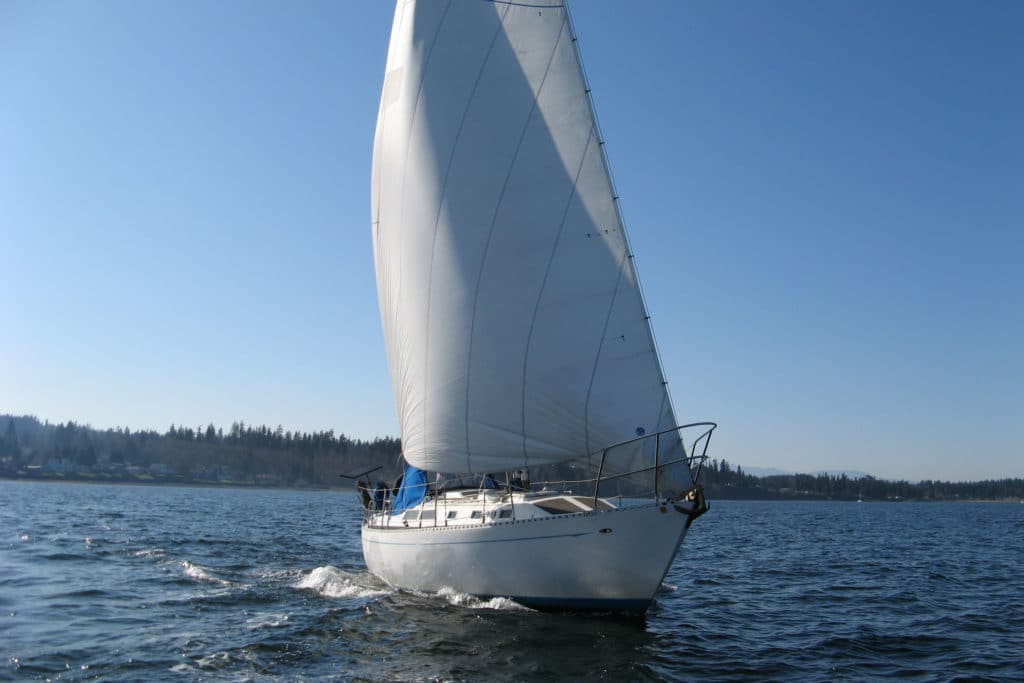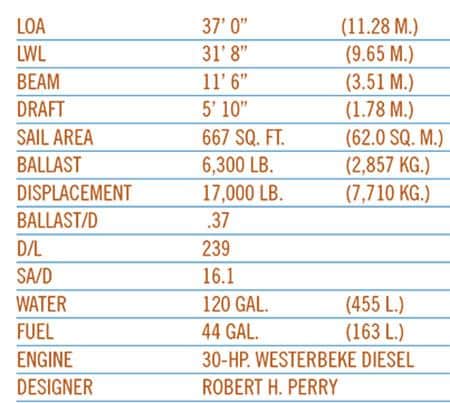
Espirt 37
Robert H. Perry designed the
Esprit 37 for Valiant Yachts, for whom his Valiant 40 was so successful. He gave it a relatively low amount of wetted surface, a low displacement-to-length ratio (for the time), a moderate cruising fin keel, and a skeg-hung rudder. This is a boat intended to be driven hard and fast across open water in any weather in safety and in reasonable comfort.
From any angle, the Esprit 37, with its sharply raked stem, handsome sheer, and well-resolved canoe stern looks purposefully seaworthy, as is expected of a Valiant.
The Esprit 37 has a hand-laminated solid-fiberglass hull to which the 6,300-pound keel is attached with 3/4-inch stainless-steel hook bolts that are cast into the lead. The deck is hand laminated with a balsa core, which delivers strength and light weight as well as good sound and thermal properties; however, at this age, it might’ve become soft where water has reached the core around hardware and fastenings.
Early boats, built by Nordic Yachts from 1977 to 1980, have been relatively free of blisters. Some Esprit hulls built by Uniflite between 1980 and 1982 suffered from blistering, both above and below the waterline. Later boats were built with an isophthalic resin that was immune to blistering.
The mast is keel stepped and masthead rigged. Earlier boats had wire rigging, but in 1979, boats built by Nordic Yachts were fitted with Navtec rod rigging, and some still have it. Although the chainplates are inboard of the toerail, they don’t seriously obstruct the side decks.
In the cockpit, it’s a bit of a tight squeeze getting past the wheel to the helmsman’s seat tucked well aft. The seats are nicely angled, deep, and a comfortable height above the sole. Cockpit lockers provide plenty of room for fenders and mooring lines, a vented gas-bottle compartment, and much more. A deck plate over the head of the rudderstock can be removed if the emergency tiller needs to be attached.
Belowdecks, the forward cabin contains a good-size V-berth with considerable storage space beneath it. Aft of it is the head, with a sink and a shower compartment with a seat. A large hanging locker is opposite the head.
In the saloon, a sleeping-length settee to starboard faces an ample L-shaped settee and table to port that converts to a generous double berth. Beneath each settee is a 60-gallon water tank. Headroom is about 6 feet 6 inches throughout.
A chart table is fitted aft of the starboard settee; the forward end of a quarter berth is the navigator’s seat. The compact but entirely sufficient U-shaped galley is on the port side, its deep double sink near enough to the boat’s centerline to drain on either tack. An abundance of lockers will hold enough stores to provision four crew for at least three weeks at sea.
The original engine was a Westerbeke diesel. It’s behind the companionway steps, which can be removed to provide access.
Under sail, the Esprit 37 is beautifully balanced, light on the helm, and accelerates nicely even in just 5 or 6 knots of wind. It’s easily sailed by a singlehander and has fine seakeeping qualities.
The Esprit 37 is a solid, no-nonsense boat that provides good accommodation for a crew of four or five on extended voyages in any waters. Asking prices range from $50,000 to $60,000.
Richard Smith and his wife, Beth, sail their Ericson Cruising 31, Kuma, in the Pacific Northwest.

|







